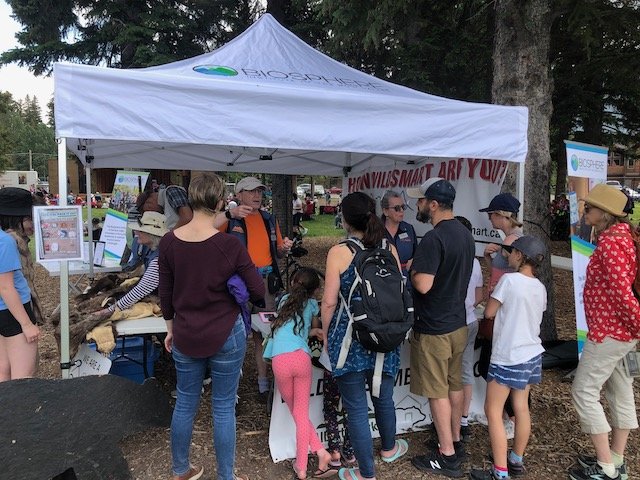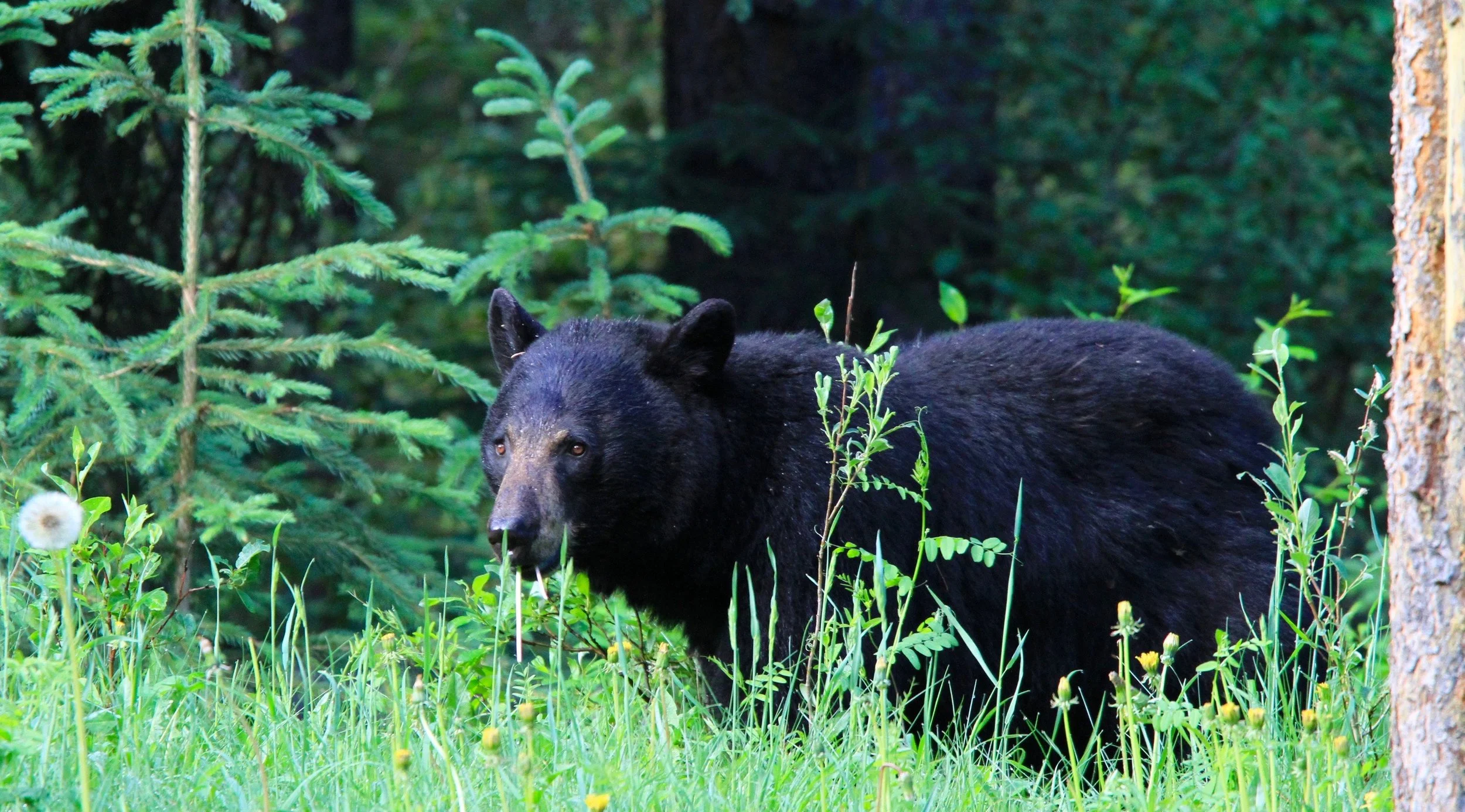Did you know that WildSmart is a program of the Biosphere Institute, a local charity? Our work relies entirely on donations and sponsors. If you would like to support our community-based efforts to promote human-wildlife coexistence, please donate!
The information below is based upon a compilation of bear information provided by government agencies and unconfirmed sightings reported by the public over the last week. It is not intended to be used as a real-time, complete record of where bears are in the valley.
BEAR ACTIVITY SUMMARY (June 30-July 7, 2022)
(Banff National Park East Gate to Bow Valley Provincial Park)
There are lots of bears (both black and grizzly) out on the landscape that are being consistently reported along trails, roadside and in residential areas and campgrounds. Even in busy places like the Canmore Nordic Centre, encounters with bears on the trails are frequent. We are sharing the valley bottoms with bears these days so we need to give them lots of space and not leave garbage or other food rewards for them to access. Please remember that bears can be encountered anywhere, anytime (not just in areas with an active warning or closure in place) so you should always be expecting to run into a bear whenever you head out on the trails in the Bow Valley and Kananaskis Country!
People need to mentally prepare themselves for encounters and remember to make lots of noise, travel in a group (ideally 4 or more), keep pets on a leash, carry bear spray and be prepared to use it in case of a close encounter. Knowing what to do when you encounter a bear is key! Even if you are going for a leisurely walk around the neighbourhood you should be carrying bear spray.
Photo taken in Harvie Heights on June 29, 2022.
During the past week a cougar warning was put in place on the Legacy Trail between the Harvie Heights Exit and the Banff National Park Boundary due to frequent sightings of a cougar feeding on a carcass in the area. The warning has since been removed but with all the recent bear sightings people often forget about some of the other wildfe that live in this valley. Bikers in particular need to make lots of noise (yell, shout) to let wildlife know they are coming down the trail and slow down to avoid surprise encounters with wildlife, especially around blind corners, at the tops of hills, or in areas with thick vegetation and poor sight lines. It is also a good idea to keep ear buds out for better situational awareness and check behind you to make sure you are not being followed by wildlife.
Elk calving season is winding down and the warnings signs around the Town of Canmore have been taken down. That does not mean people should become complacent as mother elk will still aggressively defend their calves if they feel threatened, and the calves will also continue to draw predators into town looking for an easy meal.
Stay at least 30 metres (3 school bus lengths) away from all elk and do not try to sneak past them on a trail!
You can also submit your report using the Report-A-Poacher Online form or contact your local district Fish and Wildlife office.
SOME THINGS TO ‘BEAR’ IN MIND
As part of our Trusted Messengers project, we worked with various community groups to develop conservation messages tailored to their peer or recreational user group. Messages were delivered through conversations, video, social media, or a combination. We used surveys and interviews to evaluate the effectiveness of messages delivered. We assessed target audiences’ knowledge and behaviours before and after our communications efforts. Here are some examples of the resources we created with the Dirtbag Runners of the Bow Valley. (Click on each image below to enlarge).
Buffaloberries will start to ripen in a few weeks. Please be proactive and remove berry bushes (and fruit trees) from your yard NOW before you attract a bear into town. Your tree blossoms will blossom into bear problems later! It is YOUR responsibility to make sure that bears do not have a reason to linger in your yard, resulting in bears being relocated or destroyed.
Significant amounts of waste continue to be left in day use areas and discarded along trails. Some of this waste is left behind indirectly by the wind blowing garbage off of picnic tables or peoples’ laps while they are eating. We all need to a take a quick walk around our picnic area or campsite to spot and pick up any garbage that has been left behind. Being exposed to unnatural food sources such as garbage puts wildlife at risk and increases public safety concerns around human wildlife interactions. Pack out what you pack in and leave no trace behind when you are out on the trails. It is YOUR responsibility to clean up after yourself and your pets, so make sure you pack out your dog poop baggies too! Do not leave garbage on the ground next to full garbage bins where it is accessible for wildlife. A fed bear is a dead bear and one lazy act could cost a bear its life!
Photo by Jamin Mulvey.
WILDLIFE IN THE NEWS
An elk calf was rescued from a ledge on the Bow River in Banff.
A grizzly bear has been trapped and shipped out of Canmore.
Planting new fruit-bearing trees in Canmore may be banned in a bid to protect bears and people.
A group of women in Alaska have breathed life back into an old tradition and learned a new skill in the process: sewing the intestines of bears into wearable garments.
A bear cub was rescued after getting a plastic jug stuck on its head.
Mounties issue 80 tickets in Yoho National Park after crashes kill 3 bears in 6 days.
Trail cams in Fernie show how close residents come to crossing paths with wildife out on the trails.
FOOD FOR THOUGHT?
WILDLIFE AMBASSADOR WORDS OF WISDOM
What are the Bears eating today? by Derek Ryder, Volunteer Wildlife Ambassador & IGA Interpretive Guide
Ask most folks what a bear’s favourite food is, and “berries” are always among the top answers. But it’s not berry season yet, and won’t be until later this month. The Dandelions are starting to go away (even in my neighbour’s yard). Between the end of Dandelion season & the core of berry season, bears start to take advantage of the roots of the fresh growing plants.
Grizzly bears in particular are diggers; that's where those super big claws and that big shoulder muscle that forms the hump come in handy. Bears dig for a lot of food and leave a lot of evidence that they have been digging. But what are they digging for? One of the plant families they like is the pea family. The common name of the most popular food is Sweet-Vetch, with the Latin family name Hedysarum. Grizzlies LOVE to dig for the roots of these plants, especially in the spring and fall outside of berry season. In central BC, where there are fewer berries, studies have shown Hedysarum is actually their main summer food source. The picture below is Hedysarum. Like most patches of Hedysarum you’ll find in the alpine, it had old bear digs next to it. Click on the image below to read Derek’s full article about Vetch!
CURRENT VOLUNTEER OPPORTUNITIES
The Biosphere Institute is seeking a Volunteer Social Media Content Coordinator. This posting will remain open until this volunteer role is filled.
AND NOW SOME PAWS-ITIVE NEWS
The Biosphere Institute of the Bow Valley (including WildSmart, Wildlife Ambassadors and volunteers) had an amazing time walking in the Canada Day Parade! It was great to see such a huge turnout from our amazing community! After the parade, we set up our hands-on, interactive booth in Centennial Park and enjoyed talking to many locals and visitors about wildlife ecology, safety and discussing ways to avoid and handle encounters with wildlife. Thanks to our amazing volunteers for their enthusiasm, dedication and ability to educate the people who live in, and visit, the Bow Valley!







Please remember BEARS CAN BE ENCOUNTERED ANYWHERE, ANYTIME!
Report any sightings of a bear, cougar, wolf or any aggressive wildlife in Kananaskis Country or the Bow Valley to Kananaskis Emergency Services at 403.591.7755





